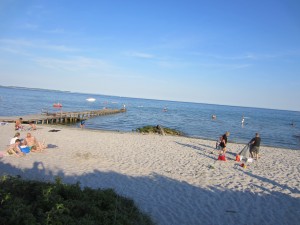Land of Beaches Posted by Bjørn A. Bojesen on Aug 19, 2012 in Uncategorized
One of the really nice things about living in Denmark are the many strand/e (beaches). If you look at a map, you see that the country is more similar to Greece than you maybe thought: The only mainland is the slender Jylland (Jutland) peninsula, the rest of the country is a bunch of ø/er (island/s). Even the capital, København (Copenhague), is on an island! In fact, no location is more than 100 km away from the kyst (coast). No wonder, then, that Danes love at bade (bathing [at home or in the ocean], literally ’to bathe’)!
With the exception of Bornholm, there are no cliffs in Denmark – it’s mostly earth, chalk, mud and sand. There are sandstrand/e (sandy beaches) at every second corner, with a sand (sand, the ’d’ is not pronounced) so white and light that it rivals the best beaches of the Mediterranean. Walking or running with bare fødder (naked feet, barefoot) on a Danish beach, before throwing yourself into the salty bølge/r (wave/s) is a true delight.
Why, then, isn’t Denmark just as popular a turistmål (tourist destination) as Greece? Obviously, it has something to do with the climate. Most of the year, Denmark is a kølig (cool, in the chilly sense!) place to walk around. Even in sommermånederne (the summer months) – juni, juli, august – you can’t be too sure if it is going to rain or what. (Remember the line ’skyer der går og kommer, det er den danske sommer’?) But when solen (the sun) does get a safe-conduct, and the temperature rises to 28 or even 30 degrees of Celsius, and you lie at a towel at the beach and watch the kids playing ball in the blikstille (dead calm, when talking about water) hav [how] (sea), all the German and Norwegian summer tourists sure know why they’re here…
Whenever there’s a string of successive sommerdag/e (summer days, that is, sunny summer days), my local beach gets really crowded. Families bring their children and dogs, and young people hang out with their friends. Very small children run about nøgne (naked, plural form; the singular form is nøgen) in the sand and in the water; older children and adults wear badebukser (bathing trunks), badedragt (bathing suite) or bikini. Now and then a woman tager solbad (is sunbathing, literally ”takes sun-bath”) topløs (topless) – but that is more uncommon now than it was a few years ago.
In the water, you can bring a badebold (beach ball) to play with your friends or your kids. Before it gets too deep you can soppe (paddle, walk) around. When it gets deeper you can dykke (dive). But of course the best thing is just to feel the water all around you and sense the happiness of the other people and the tranquility of the sea and just svømme (swim) and svømme and svømme…

Build vocabulary, practice pronunciation, and more with Transparent Language Online. Available anytime, anywhere, on any device.
About the Author: Bjørn A. Bojesen
I was born in Denmark, but spent large parts of my childhood and study years in Norway. I later returned to Denmark, where I finished my MA in Scandinavian Studies. Having relatives in Sweden as well, I feel very Scandinavian! I enjoy reading and travelling, and sharing stories with you! You’re always welcome to share your thoughts with me and the other readers.




